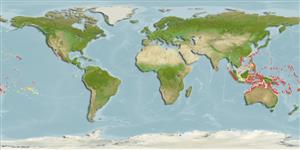Common names from other countries
>
Blenniiformes (Blennies) >
Blenniidae (Combtooth blennies) > Blenniinae
Etymology: Meiacanthus: Greek, meion = less = lessen + Greek, akantha = thorn (Ref. 45335).
More on author: Günther.
Environment: milieu / climate zone / depth range / distribution range
นิเวศวิทยา
เกี่ยวกับทะเล,น้ำเค็ม เกี่ยวกับหินโสโครก; ระดับความลึก 0 - 30 m (Ref. 128797). Tropical; 30°N - 24°S
Western Pacific: Bali and the Philippines east to Samoa, north to Ryukyu Islands, south to Rowley Shoals, the southern Great Barrier Reef, and New Caledonia; throughout Micronesia. Replaced by the uniformly yellow species ovalauensis in Fiji, and by Meiacanthus tongaensis in Tonga (Ref. 37816).
ขนาด / น้ำหนัก / Age
Maturity: Lm ? range ? - ? cm
Max length : 11.0 cm TL เพศผู้/กระเทย; (Ref. 9710)
Short description
เครื่องมือที่ใช้ในการแยกชนิดสัตว์,สิ่งมีชีวิตออกจากกัน | สัณฐานวิทยา | ความยาวต่างๆ
เงี่ยงครีบหลัง (รวม) : 4; ก้านครีบอ่อนที่หาง (รวม) : 25 - 28; เงี่ยงครีบก้น: 2; ก้านครีบอ่อนที่ก้น: 15 - 18. Identified by the blue-edged diagonal black line from the eye and yellow dorsal fin or back. Adults have long filaments on the caudal fin tips; length without filaments (Ref. 48636).
Adults are found solitary or in pairs (Ref. 90102) in lagoon and seaward reefs below the surge zone to 30 m depth (Ref. 9710). A common species, often seen along slopes and drop-offs, adults sometimes in small groups (Ref. 48636). Feed on zooplankton and also on small benthic invertebrates. Inoffensive, but immune from predation (Ref. 9710). Oviparous. Eggs are demersal and adhesive (Ref. 205), and are attached to the substrate via a filamentous, adhesive pad or pedestal (Ref. 94114). Larvae are planktonic, often found in shallow, coastal waters (Ref. 94114). Mimicked by Ecsenius bicolor and Plagiotremus laudanus (Ref. 90102).
Life cycle and mating behavior
Maturities | การสืบพันธุ์ | Spawnings | Egg(s) | Fecundities | ตัวอ่อน
Oviparous, distinct pairing (Ref. 205).
Myers, R.F., 1991. Micronesian reef fishes. Second Ed. Coral Graphics, Barrigada, Guam. 298 p. (Ref. 1602)
IUCN Red List Status (Ref. 130435)
CITES (Ref. 128078)
Not Evaluated
Human uses
การประมง: การค้า; สถานที่แสดงสัตว์และพืชน้ำ: การค้า
เครื่องมือ
Special reports
Download XML
แหล่งที่มาจากอินเตอร์เน็ต
Estimates based on models
Preferred temperature (Ref.
115969): 25.6 - 29.3, mean 28.5 (based on 1837 cells).
Phylogenetic diversity index (Ref.
82804): PD
50 = 0.5000 [Uniqueness, from 0.5 = low to 2.0 = high].
Bayesian length-weight: a=0.00562 (0.00258 - 0.01228), b=3.06 (2.87 - 3.25), in cm Total Length, based on LWR estimates for this (Sub)family-body shape (Ref.
93245).
ระดับชั้นอาหาร (Ref.
69278): 3.5 ±0.41 se; based on food items.
ความสามารถในการกลับคืนสู่ปกติ (Ref.
120179): ความสูง, เวลาต่ำสุดที่จะทำให้ประชากรเพิ่มขึ้นเป็น 2 เท่าใช้เวลาน้อยกว่า 15 เดือน (Preliminary K or Fecundity.).
Fishing Vulnerability (Ref.
59153): Low vulnerability (10 of 100).
